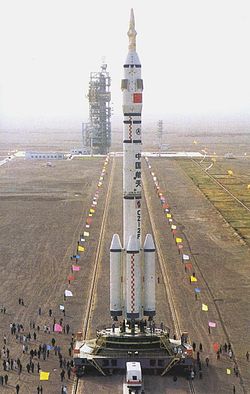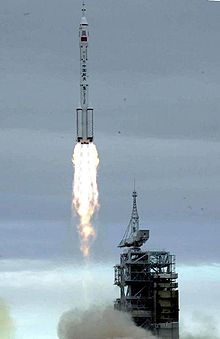- Long March 2F
-
Long March 2F
Before the launch of Shenzhou 5 using a Long March 2F at Jiuquan Satellite Launch CenterFunction Man-rated orbital launch vehicle Manufacturer CALT Country of origin  China
ChinaSize Height 62 metres (203 ft)[1] Diameter 3.35 metres (11.0 ft)[1] Mass 464,000 kilograms (1,020,000 lb)[1] Stages 2 Capacity Payload to
LEO8,400 kilograms (19,000 lb)[1] Associated rockets Family Long March Launch history Status Active Launch sites SLS, JSLC Total launches 9 Successes 9 Maiden flight 19 November 1999 The Long March 2F (Chinese: 长征二号F火箭 Chang Zheng 2F), also known as the CZ-2F, LM-2F and Shenjian,[1] is a Chinese manned orbital carrier rocket, part of the Long March rocket family. Designed to launch manned Shenzhou spacecraft, the Long March 2F is a man-rated two-stage version of the Long March 2E rocket, which in turn was based on the Long March 2C launch vehicle.[2] It is launched from complex SLS at the Jiuquan Satellite Launch Centre. The Long March 2F made its maiden flight on 19 November 1999, with the Shenzhou 1 spacecraft. After the flight of Shenzhou 3, CPC General Secretary and President Jiang Zemin named the rocket 'Shenjian' meaning 'Divine Arrow'.[3]
On 15 October 2003, a Long March 2F launched Shenzhou 5, China's first manned spaceflight. It has since launched the Shenzhou 6 mission and the Shenzhou 7 mission into orbit.[4]
Contents
Differences from the Long March 2E
Externally, the rocket is little different from the Long March 2E from which it was derived. Most of the changes are redundant systems to improve safety, although there are some structural modifications which allow the rocket to support the heavier fairing required by the Shenzhou capsule. The rocket is also capable of lifting heavier payloads with the addition of extra boosters to the first stage.[5]
The rocket also has an "advanced fault monitoring and diagnosis system to help the astronauts escape in time of emergency", and is the first Chinese made rocket to be assembled and rolled out to its launch site vertically.[6]
Vibration issues
During the Shenzhou 5 flight, Yang Liwei became sick due to heavy vibrations from the rocket. Although the problem was reduced somewhat by modifications to the rocket, vibrations were reported again in Shenzhou 6 necessitating further changes. According to Jing Muchun, chief designer of the Long March 2F "We made changes to the pipelines of the rocket engine, adjusting its frequency. A new design for the pressure accumulator produced evident results. The vibration has now been reduced by more than 50 percent." [7]
Launch history
Date & Time (GMT) Payload Outcome Remarks 19 November 1999, 22:30 Shenzhou 1 Success First unmanned test of the Shenzhou capsule 9 January 2001, 01:00 Shenzhou 2 Success Second unmanned test of the Shenzhou capsule, carried live animals 25 March 2002, 14:00 Shenzhou 3 Success Third unmanned test of the Shenzhou capsule. 29 December 2002, 16:40 Shenzhou 4 Success Final unmanned test of the Shenzhou capsule. 15 October 2003, 01:00 Shenzhou 5 Success China's first manned spaceflight 12 October 2005, 01:00 Shenzhou 6 Success Second manned spaceflight, first with two crew members 25 September 2008, 13:10 Shenzhou 7 Success Third manned spaceflight, first with three crew members, first to feature Extra-vehicular activity 29 September 2011, 13:16 Tiangong 1 Success The first Chinese space station, with a modified version of Long March 2F 31 October 2011, 21:58 Shenzhou 8 Success Unmanned spaceflight to test automatic rendezvous and docking, with a modified version of Long March 2F Specifications
- Stage number: 0 - Strap-on boosters x 4
- Gross mass: 41,000 kg
- Empty mass: 3,200 kg
- Thrust (vac): 4 x 814 kN
- Isp: 291 seconds (2.9 kN·s/kg)
- Burn time: 128 seconds
- Diameter: 2.3 m
- Span: 8.0 m
- Length: 15.3 m
- Propellants: N2O4 / UDMH
- Engines: 1 x YF - 20B per booster = 4
- Stage number: 1 - Core stage
- Gross mass: 196,500 kg
- Empty mass: 9,500 kg
- Thrust (vac): 3,256 kN
- Isp: 289 seconds (2.8 kN·s/kg)
- Burn time: 166 seconds
- Diameter: 3.4 m
- Length: 23.7 m
- Propellants: N2O4 / UDMH
- Engine: 4 x YF - 20B
- Stage number: 2 - Final stage
- Gross mass: 91,500 kg
- Empty mass: 5,500 kg
- Thrust (vac): 831 kN
- Isp: 289 seconds (2.8 kN·s/kg)
- Burn time: 300 seconds
- Diameter: 3.4 m
- Length: 15.5 m
- Propellants: N2O4 / UDMH
- Engine: 1 x YF - 25/23
References
- ^ a b c d e Mark Wade. "CZ-2E". Encyclopedia Astronautica. http://www.astronautix.com/lvs/cz2e.htm. Retrieved 2008-05-02.
- ^ "LM-2F - Launch Vehicle". CGWIC. http://www.cgwic.com/LaunchServices/LaunchVehicle/LM2F.html. Retrieved 2010-12-13.
- ^ "CZ". Astronautix.com. http://www.astronautix.com/lvs/cz.htm. Retrieved 2010-12-13.
- ^ "China to launch Shenzhou-7 spacecraft on Thursday". news.xinhuanet.com. English Xinhua. 2008-09-24. http://news.xinhuanet.com/english/2008-09/24/content_10102808.htm. Retrieved 2010-12-13.
- ^ "Long March 2F - Summary". Spaceandtech.com. 1999-11-20. http://www.spaceandtech.com/spacedata/elvs/longmarch2f_sum.shtml. Retrieved 2010-12-13.
- ^ [1][dead link]
- ^ "CCTV International". Cctv.com. 2008-09-25. http://www.cctv.com/english/20080925/105699.shtml. Retrieved 2010-12-13.
Expendable launch systems Current Ariane 5 · Atlas V · Delta (II · IV) · Dnepr-1 · GSLV · H-IIA · H-IIB · Kaituozhe-1 · Kosmos-3M · Long March (1D · 2C · 2D · 2F · 3A · 3B · 3C · 4B · 4C) · Minotaur (I · IV) · Naro-1 · Paektusan · Pegasus · Proton (K · M) · PSLV · Rokot · Safir · Shavit · Shtil' · Start-1 · Strela · Soyuz (U · FG · 2) · Taurus · Unha · VLS-1 · Volna · Zenit (2 · 2M · 3SL · 3SLB)
Planned Angara · Athena (Ic · IIc) · GSLV III · Haas · Long March (5 · 6 · 7) · Minotaur V · RPS-420 · Rus-M · Soyuz-1 · Simorgh · TSLV · Taurus II · Tsyklon-4 · Vega · Zenit-3F
Previous Ariane (1 · 2 · 3 · 4) · ASLV · Athena (I · II) · Atlas (B · D · E/F · G · H · I · II · III · LV-3B · SLV-3 · Able · Agena · Centaur) · Black Arrow · Caleb · Conestoga · Delta (A · B · C · D · E · G · J · L · M · N · 0100 · 1000 · 2000 · 3000 · 4000 · 5000 · III) · Diamant · Energia · Europa · Falcon 1* · Feng Bao 1 · H-I · H-II · J-I · Juno I · Juno II · Kosmos (1 · 2I · 3) · Lambda (4S) · Long March (1 · 2A · 2E · 3 · 4A) · Mu (4S · 3C · 3H · 3S · 3SII · V) · N1 · N-I · N-II · Pilot · R-7 (Luna · Molniya (M) · Polyot · Soyuz (L · M · U2) · Soyuz/Vostok · Sputnik · Voskhod · Vostok (L · K · 2 · 2M)) · Saturn (I · IB · V · INT-21) · Scout · SLV · Sparta · Thor (Able · Ablestar · Agena · Burner · Delta · DSV-2U) · Thorad-Agena · Titan (II GLV · IIIA · IIIB · IIIC · IIID · IIIE · 34D · 23G · CT-3 · IV) · Tsyklon (2 · 3) · Vanguard
- - Falcon 1 designed for partial reuse, however recovery failed on the first three flights and remaining vehicles were flown expendably
China National Space Administration (CNSA) Robotic programs PastCurrentIn developmentHuman spaceflight
programsCurrentIn developmentPast missions Spaceports People ScientistsDu Qinghua · Fan Ruixiang · Hu Haichang · Huang Chunping · Long Lehao · Luan Enjie · Ouyang Ziyuan · Qi Faren · Qian Xuesen · Sun Laiyan · Wan Hu · Wang Yongzhi · Wei Yiqing · Ye Peijian · Zhuang Fenggan · Zhang Guitian · Zhao Jiuzhang · Zhu MiaolongAstronautsLong March rockets LM 1 family 
LM 2 family LM 3 family LM 4 family LM 5 family Light · Medium · A · B · C · D · E · FLM 6 family Long March 6LM 7 family Long March 7Shenzhou program Unmanned Manned Planned Hardware Related missions Other Siziwang Banner landing siteCategories:- Chinese space program
- Shenzhou programme
- Long March rockets
- Stage number: 0 - Strap-on boosters x 4
Wikimedia Foundation. 2010.




